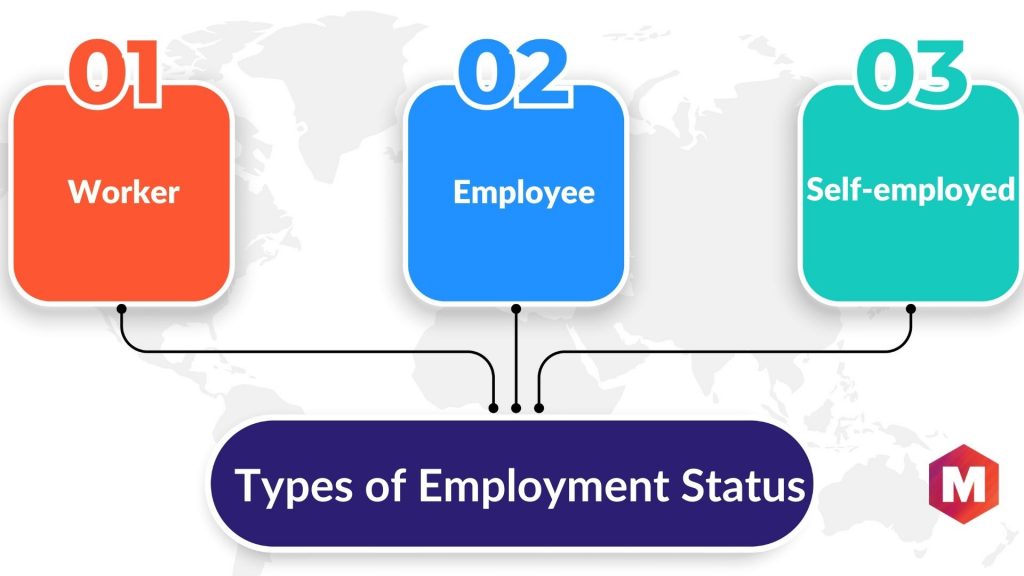Table of Contents
What Is Employment Status?
Employment status is the legal classification of a worker which determines their rights and obligations in employment law. The main types of employment status are employee, worker, and self-employed. Employment status affects several employment rights and obligations such as entitlement to the national minimum wage, paid holidays, and protected leave.
Employment status can also be called as the connection between an employee and their present or former employer. This relationship is what dictates the duties, privileges, and restrictions an employee has in their work. Employment status classification is used to determine an individual’s rights in the workplace.
Employment status is usually determined by the type of contract a worker has with their employer. For example, an employee will have a contract of employment, whereas a worker will have a contract for services. Employment status can also be determined by how much control an employer has over a worker’s day-to-day activities. For example, an employee is usually under more control than a worker.
An individual’s employment status affects several key areas of their work life, including:
- Employment law entitlements (e.g. the national minimum wage, paid holidays)
- Tax and national insurance contributions
- Employment tribunal claims
- Pension rights
Meaning
Employment status determines many things, including what personal and financial information an employer can request, an employee’s legal status, and the employee’s level of employment security. It is the legal classification of a person’s job.
The right employment status can lead to a more secure employment package and greater employment security. Therefore, it is important to understand what each employment status means and how it can affect an individual’s career.
It is also worth noting that employment status can change over time. For example, a person who is classified as a contract worker may eventually become a permanent employee. Conversely, a person who is classified as a permanent employee may eventually become a contract worker. A person’s employment status is determined by many factors, including the type of work they do, the length of their employment, and the country in which they work.
3 Types of Employment Status
1. Worker
Workers have more rights than self-employed people, but fewer rights than employees. Even if they don’t want to, a worker has the arrangement to do work or services and is required to come in even if they are not enthusiastic about it.
They are not allowed to subcontract their responsibilities out to anybody else and, as a result of this, they do not work as a limited company. Rights of workers include
- The right to the national minimum wage
- The right to paid holiday
- The right to not work more than 48 hours a week on average (unless they agree to opt-out of this limit )
- The right to statutory sick pay
- The right to join a union
- Payslips
- Protection against all sorts of unlawful discrimination
2. Employee
Employees have the most rights in employment law. Employees are workers who have a contract of employment. They enjoy all the protections of a ‘worker’ along with additional employment rights and protections.
An individual is considered an employee if they have a contract of employment. Unless they are on leave – such as sick leave or parental lead – employees are usually required to work regularly. In addition to paid holidays, redundancy procedures may apply to them.
Most workplaces have Required Monthly Hours (RMH) that employees can’t go below, and they also can’t ask someone else to do their work for them. Along with all the employment protections of a ‘worker’, employees also have the following protections
- Statutory Sick Pay (SSP)
- Statutory Redundancy Pay (SRP)
- Protections against unfair dismissal
- Minimum notice periods
- The right to request flexible working
- Statutory maternity, adoption, paternity, and shared parental leave and pay (workers don’t receive leave – just the pay)
3. Self-employed
Self-employed people are in business for themselves and control their work. They’re also known as contractors or freelancers. Self-employed people don’t have an employment contract with an employer.
They can work for more than one client or customer at the same time and they’re free to choose when and where they work. They’re also free to hire other people to work for them.
Self-employed people have some employment rights, but not as many as employees or workers. For example, they don’t have the right to paid holiday or sick pay.
Self-employed people are responsible for paying their taxes and National Insurance. They can claim some expenses related to their work, such as travel costs.
Signs someone is self-employed:
- When they’re not working, employees don’t accrue holiday or sick pay
- They provide estimated prices or quotes for their work
- They submit invoices after their work
Why is it Important to determine Employment Status?
Employment status is important because it determines an individual’s employment law entitlements. It also affects an individual’s tax and national insurance contributions, as well as their pension rights.
Employees have the most rights in employment law, followed by workers, and then self-employed individuals. It is important to determine an individual’s employment status because it affects their entitlements, as well as their tax and national insurance contributions.
If you’re seeking to employ someone to work at your small business, you’ll need to select the proper employment status for the job they’ll be performing. The employment status you choose will largely determine the dynamic of your new relationship with your employee. Choose accordingly to best fit how you envision working together.
What employment status should I select when recruiting for my small business?
The type of business you have, the structure of your workforce, and how much control you want over your workers will all factor into deciding what employment status to use when hiring for your small business.
If you’re looking for someone to work regular hours with little deviation, are OK with having less control over their work schedule, and want the worker to be an important part of your business, then you should consider hiring an employee.
If you’re looking for someone to work irregular hours, need more control over when and how they work, and are OK with a less formal working relationship, then you should consider hiring a self-employed contractor. If you’re looking for someone to fill a short-term need or project, then hiring a worker on a fixed-term contract may be the best option.
No matter what employment status you choose when hiring for your small business, make sure you are clear about the expectations of the working relationship from the start. This will help avoid any misunderstandings or problems down the road. Employment status is important because it determines an individual’s employment law entitlements.
It also affects an individual’s tax and national insurance contributions, as well as their pension rights. Employees have the most rights in employment law, followed by workers, and then self-employed individuals. It is important to determine an individual’s employment status because it affects their entitlements, as well as their tax and national insurance contributions.
Work out your Employment Status for Employment Rights
It is important to determine your Employment Status to know what Employment Rights you are entitled to.
Employment Status is determined by several factors including how much control your employer has over you if you are working for a business or undertaking work as part of a business, and whether you are under a contract of employment.
If you are an employee, you will be entitled to most Employment Rights, including the right to paid annual leave, the right to Statutory Sick Pay, and the right to maternity, paternity, and adoption leave.
If you are a worker, you will be entitled to some Employment Rights, including the right to paid annual leave, and the right to Statutory Sick Pay. If you are self-employed, you will not be entitled to Employment Rights.
Conclusion!
In the end, it is important to remember that your employment status can have a big impact on your personal and financial life. Make sure you understand the difference between being an employee, an independent contractor, and other types of workers. This will help you know what to expect from your employer and how to file your taxes correctly.
You can also use this personal or financial information to negotiate for more employment security or a written contract. Employment status is an important part of your job, so it’s worth taking the time to understand it.
What do you think? Do you have any questions about employment status? Let us know in the comments below.
Liked this post? Check out the complete series on Human resources

